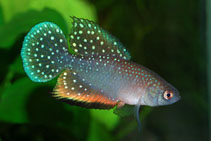| Family: |
Rivulidae (Rivulines), subfamily: Cynolebiinae |
| Max. size: |
7 cm TL (male/unsexed) |
| Environment: |
benthopelagic; freshwater; pH range: 7 - 7.09999990463257; dH range: 3, non-migratory |
| Distribution: |
South America: Jaguaribe and Mossoró River basins and adjacent coastal plains in Brazil. |
| Diagnosis: |
Dorsal soft rays (total): 15-25; Anal soft rays: 19-24; Vertebrae: 28-30. Caudal peduncle of female with black spots. Male's anal fin with gray to black distal stripe; unpaired fins dark bluish gray; basihyal broad, 70-95% in length; conspicuous contact organs on scales of body sides. Second pharyngobranchial teeth, 5-10. Dorsal-fin rays 21-25 in male, 15-20 in female; anal-fin rays 22-24 in male, 19-23 in female; caudal-fin rays 23-36, caudal fin subtruncate in male, rounded in female (Ref. 49550). |
| Biology: |
Bottom spawner, 4 months. Is very difficult to maintain in aquarium (Ref. 27139). |
| IUCN Red List Status: |
Least Concern (LC); Date assessed: 07 November 2018 Ref. (130435)
|
| Threat to humans: |
harmless |
Source and more info: www.fishbase.org. For personal, classroom, and other internal use only. Not for publication.

